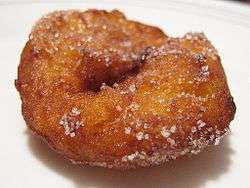Buñuelo
A buñuelo (Spanish: [buˈɲwelo]; alternatively called bimuelo, birmuelo, bermuelo, burmuelo, or bonuelo; Catalan: bunyol, IPA: [buˈɲɔl]) is a fried dough fritter found in Southwest Europe, Latin America, and parts of Africa and Asia. It is a popular snack in Argentina, Belize, Bolivia, Colombia, Cuba, Ecuador, El Salvador, Greece, Guam, Guatemala, India, Italy, Israel, Mexico, Nicaragua, Panama, the Philippines, Puerto Rico, Spain, Turkey, Uruguay, and Venezuela. It is traditionally prepared at Christmas, Ramadan, and among Sephardic Jews at Hanukkah. It will usually have a filling or a topping. In Mexican cuisine, it is often served with a syrup made with piloncillo.[1]
 Typical Spanish pumpkin buñuelo | |
| Alternative names | Bunyol, bimuelo, birmuelo, bermuelo, burmuelo, bonuelo |
|---|---|
| Type | Doughnut, fritter |
| Course | Snack, bread |
| Place of origin | Spain |
| Region or state | Southwest Europe, Latin America, and parts of Africa and Asia |
| Serving temperature | Hot or room temperature |
Buñuelos are first known to have been consumed among Spain's Morisco population. They typically consist of a simple, wheat-based yeast dough, often flavored with anise, that is thinly rolled, cut or shaped into individual pieces, then fried and finished off with a sweet topping. Buñuelos may be filled with a variety of things, sweet or savory. They can be round in ball shapes or disc-shaped. In Latin America, buñuelos are seen as a symbol of good luck.[2]
History
Fritters are known in Mediterranean cuisine from the work of Cato the Elder who included a recipe with the name "balloons", in his book De Agri Cultura , written in the second century BC. In that recipe, flour and cheese balls were fried and served with a spread made of honey and poppy seeds.[3]
The first society, after the Roman one, that consumed buñuelos was the Moorish. Its citizens, people of humble means, who inhabited the southern territories of the Iberian Peninsula and occupied low-level jobs, also served as street vendors selling buñuelos. In Seville and Granada, honey-fried buñuelos covered in honey were typical dessert. On the other hand, this specialty was adopted by the gypsies after the Moorish expulsion and perpetuated until today.
A 19th century recipe from California, described as pasta de freir (dough to fry) is made by folding whipped egg whites into a mixture of flour, water, sugar, oil and orange blossom water. This is used as a batter to fry apples or other types of fruit. A variation called suspiros de monjas (nun's sighs) includes butter and egg yolks. Buñuelos de Valparaiso are garnished with walnuts and sherry or maraschino flavored simple syrup.[4]
Regional adaptations
.jpg)
_doughnuts_with_ube_filling.jpg)
- In Spain, the buñuelos are a dessert and snack typical in many autonomous communities and, especially, during their regional holidays. Each territory incorporates its own ingredients and its own tradition. One of the best known is the wind buñuelo, a species of fritter.

In Catalonia, they are consumed mostly during Lent. The most famous are those of wind, cream and Brunyols de l'Empordà. They are usually eaten as a snack or to accompany coffee after lunch.
In Valencia, the highest consumption is concentrated in festivities such as Fallas de Valencia, where pumpkin buñuelos are made.
In the Balearic Islands, there are sweet fritters for different parties of the year (Las Vírgenes, Todos los Santos, Lent, etc.) and, depending on the occasion, they can contain potato or sweet potato, Mahón cheese, dried figs, etc.
In Madrid and Andalusia, they are consumed with special assiduity during the Festival of Saints, during which it was customary for women to prepare them in the houses and sell them or they will give to the neighbors, especially in the villages.
However, in some regions of Spain, buñuelos find a strong competitor in churros, which are increasingly widespread at parties normally associated with buñuelos. On the other hand, in Catalonia, churros are almost only consumed by tourists, the Catalans prefer the `` xuixo s or `` chuchos in churrerías or the buñuelos in their multiple forms in bakeries, bakeries or in houses .
- In Colombia they are made with a small curd white cheese and formed into doughy balls then fried golden brown. It is a traditional Christmas dish, served along with natillas and manjar blanco.
- In Cuba they are traditionally twisted in a figure 8 and covered in an anise caramel. The dough contains cassava and malanga.
- In the Dominican Republic, buñuelos are rolled into balls from a dough made of cassava (called yuca) and eggs. They are then covered in a cinnamon sugar syrup, often using coconut milk instead of water.
- In Nicaragua, buñuelos are made from, cassava, eggs, and white grating cheese. The buñuelos are rolled into balls and deep fried. They are served alongside a syrup made of sugar, water, cinnamon sticks, and cloves. They are eaten year-round, and are a typical side-dish or snack served during holidays.
- In the Philippines, buñuelos (also called bunwelos, bunuelos, binowilos, etc.) can be shaped like a ball, a pancake, a cylinder, or even a doughnut. They are commonly eaten with tsokolate, the local hot chocolate drink.[5][6][7] There are also unique local variants of buñuelos, the most common is cascaron (also bitsu-bitsu) which is made with ground glutinous rice (galapong) rather than regular flour. Another variant is bunwelos na saging, which is made with mashed bananas added into the mixture, similar to maruya, a Filipino banana fritter.[8][9][10]
- In Puerto Rico, buñuelos are small and round. The dough is often made with milk, baking powder, egg, and flour. Apio, cassava, grated corn, cornflour, potato, sweet potatoes, taro, yams, rice flour, chickpea flour, and sweet plantains can be added and are well known in Puerto Rican cuisine scenes 1800's. They are often filled with cheese and ham for breakfast. They are popular around the Christmas holiday served in syrup made from sugar and spices or honey and spices or lemon, suger and ginger or guava syrup.
- In Mexico buñuelos are made from a yeasted dough with a hint of anise that is deep-fried, then drenched in a syrup of brown sugar, cinnamon, and guava. Buñuelos are commonly served in Mexico and other Latin American countries with powdered sugar, a cinnamon and sugar topping, or hot sugar cane syrup (piloncillo) and are sold in fairs, carnivals, and Christmas events such as Las Posadas.
- In Peru, buñuelos resemble picarones in shape (round and ring shaped) but lack yam or squashes as in picarones. Made of flour, water, sugar, and anise, and yeast. They are served with a sweet syrup made of chancaca (sugar cane derived sweet). Common street food native to Arequipa.
- In Italy, they are usually served with cream, and popular during Carnival time, in particular in the North-East of the country.
- in Uruguay sweet buñuelos are made with apples and bananas and covered in sugar. Salty variations are traditionally made of spinach, cow fat and seaweed. Seaweed buñuelos are considered a delicacy in Rocha Department.
There are also buñuelos in Turkey, India, Puerto Rico, and Cuba; buñuelos in Russia. Jews in Turkey make buñuelos with matzo meal and eat them during Passover.
In many Latin American countries, this particular dish can also be made with flour tortillas, and covered in sugar or cinnamon.
In popular culture
Buñuelo was featured on the Netflix TV series, Street Food (TV series) in season 2.[11]
References
- Grodinsky, Peggy (6 September 2006). "Pump up the flavor with piloncillo". Houston Chronicle. Retrieved 23 January 2014.
- Herrera, Jennifer. "Buñuelos: Tasty dessert symbolic of good luck". San Antonio Express-News. Retrieved 3 March 2015.
- After Cato's, the first known recipe for a dough for donuts seems to be the collection by Apicio, in his work De re coquinaria, in the first century of the Christian era.
- El cocinero español by Encarnación Pinedo, 1898
- Fernandez, Doreen (1994). Tikim: Essays on Philippine Food and Culture. Anvil Pub. p. 46. ISBN 9789712703836.
- "Bunwelos". About Filipino Food. Retrieved 14 December 2018.
- "Bunuelos (fried dough or doughnuts)". Kusina ni Manang. Retrieved 14 December 2018.
- "Pinoy Meryenda: Bunuelos making (Cascaron)". SweetestCherry. Retrieved 14 December 2018.
- "Glossary of Filipino Food ...and essays on the world's "original fusion cuisine" too". Filipino ricecakes, sweets, and other snacks - B. Retrieved 14 December 2018.
- "Bunwelos na Saging". Pinoy Hapagkainan. Retrieved 14 December 2018.
- Cortez, Mario A. "'Street Food: Latin America' Is a Mouth-Watering, Welcome Escape". Remezcla. Remezcla. Retrieved 3 August 2020.
External links
| Wikimedia Commons has media related to Buñuelos. |
| Wikibooks Cookbook has a recipe/module on |

